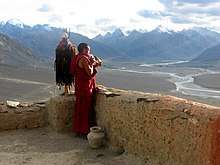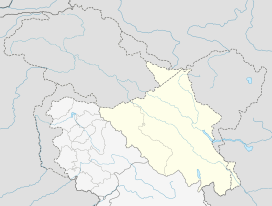Stongdey Monastery
Stongdey Monastery, often written Stongde, Stongday, Tonday or Thonde, is a flourishing Buddhist monastery in Zanskar, Ladakh, northern India, approximately 18 km north of Padum, on the road to Zangla.[1]
| Stongdey Monastery | |
|---|---|
 Sunset concert on the gompa roof | |
| Religion | |
| Affiliation | Tibetan Buddhism |
| Sect | Gelug |
| Deity | Je Tsongkhapa |
| Location | |
| Location | Zanskar River Valley, Ladakh, India |
 Location within India  Stongdey Monastery (India) | |
| Geographic coordinates | 33°31′9.34″N 76°59′17.59″E |
| Architecture | |
| Founder | Lama Lhodak Marpa Choski Lodos |
| Part of a series on |
| Tibetan Buddhism |
|---|
 |
|
|
|
Practices and attainment |
|
Institutional roles |
|
History and overview |
The gompa was founded in 1052 by Naropa's disciple, the famous translator Lama Marpa Lotsawa (1012-1097). It was taken over by the Gelugpa about four centuries later and became dedicated to Je Tsongkhapa.[1][2]
It is the second largest monastic institution in Zanskar, with a community of about 60 Gelukpa monks.[1] Every year the Gustor Festival is held on the 28th and 29th day in the eleventh month of the Tibetan calendar.
There are seven temples in all. The Tshogs-khang is decorated with exquisite painting including some with deities on a black background outlined in gold.[2]
Footnotes
- "Stongdey Monastery". Buddhist-temples.com. Retrieved 20 October 2009.
- Rizvi (1996), p. 255.
References
- Janet Rizvi. (1996). Ladakh: Crossroads of High Asia. Second Edition. Oxford University Press, Delhi. ISBN 0-19-564546-4.
- Schettler, Margaret & Rolf (1981). Kashmir, Ladakh & Zanskar. Lonely Planet Publications. South Yarra, Victoria, Australia. ISBN 0-908086-21-0.